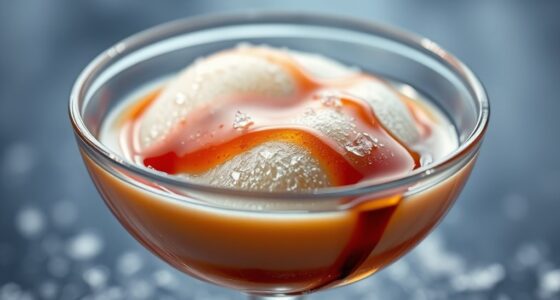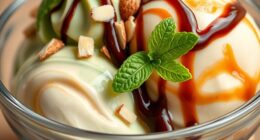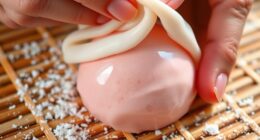Vanilla’s flavor comes from a complex blend of compounds like vanillin, which develop during extraction, curing, and fermentation. When you extract vanilla, these molecules interact and transform, releasing layered aromas and tastes. Heating or processing causes chemical changes that enhance flavor complexity. Understanding these interactions helps explain vanilla’s rich, versatile profile. If you’re curious about how these molecules create that signature aroma, there’s much more to explore.
Key Takeaways
- Vanilla extracts contain a complex mixture of compounds like vanillin, p-hydroxybenzaldehyde, and vanillic acid that influence flavor depth.
- Vanillin is the primary molecule responsible for vanilla’s characteristic aroma, but its interaction with other compounds enhances complexity.
- During extraction and cooking, heat induces chemical transformations that release different flavor notes from vanilla compounds.
- The interaction and transformation of molecules create a layered flavor profile, affecting how vanilla’s aroma and taste are perceived.
- Understanding vanilla’s chemical interactions and transformations allows for better control of flavor release in culinary and commercial applications.

Have you ever wondered what makes vanilla so universally appealing? The answer lies deep within its chemistry, especially in how vanilla compounds form and interact to create that warm, inviting aroma. Vanilla compound formation involves a complex process where various molecules come together, producing the signature scent and flavor we associate with vanilla. At the core of this is vanillin, the primary flavor molecule responsible for vanilla’s distinctive taste. But vanilla’s magic isn’t just about vanillin; it’s about how this molecule interacts with others, both during extraction and in your mouth. When you indulge in vanilla-flavored treats, you’re experiencing a symphony of flavor molecule interactions, where vanillin binds with sensory receptors, triggering pleasurable responses.
In the world of vanilla extracts, understanding vanilla compound formation helps explain why natural vanilla beans are so prized. These beans contain a rich mix of hundreds of compounds, including vanillin, that develop during curing and fermentation. This complex blend facilitates flavor molecule interaction, resulting in a depth and richness that synthetic vanilla often lacks. When you extract vanilla from beans, these compounds dissolve into alcohol or other solvents, creating an intricate matrix of flavors. This matrix is essential because it influences how the flavor is released when you consume the product. The more nuanced the vanilla compound formation, the more layered and authentic the flavor will feel on your palate.
Vanillin itself can be synthesized or extracted, but natural vanilla’s appeal partly stems from the broader compound formation within the bean. These additional molecules—like p-hydroxybenzaldehyde and vanillic acid—enhance the overall flavor profile through flavor molecule interaction. These interactions aren’t static; they evolve as the vanilla is heated or mixed, releasing different notes and intensities. When baking, for instance, heat causes these compounds to break down or transform, intensifying the vanilla aroma and flavor. This process demonstrates how understanding vanilla compound formation and flavor molecule interaction helps chefs and food scientists craft more aromatic and flavorful products.
When you taste vanilla, you’re experiencing a carefully balanced interplay of molecules that interact in your senses. The way vanillin and its companions react during cooking or extraction determines how the flavor is released and perceived. It’s a delicate dance of chemistry that makes vanilla so versatile and beloved. By understanding these underlying processes, you gain a greater appreciation for why vanilla is more than just a flavor—it’s a sophisticated chemical symphony that delights your senses and elevates countless desserts and dishes.
Frequently Asked Questions
How Does Vanilla Extract Differ From Synthetic Vanillin?
Vanilla extract comes from vanilla bean composition, containing natural vanillin along with other flavorful compounds, while synthetic vanillin is produced through chemical vanillin extraction methods. You’ll notice that extract offers a richer, more complex flavor profile, thanks to these additional compounds. On the other hand, synthetic vanillin is more affordable and has a cleaner, more uniform taste. Your choice depends on whether you prefer natural complexity or cost-effective consistency.
What Natural Sources Contain Vanilla Compounds Besides Vanilla Beans?
You’ll find vanilla compounds in botanical sources beyond vanilla beans, such as orchids from the genus Vanilla, which produce aromatic compounds used in flavoring. Some other plants, like Tiaré flowers and certain species of Orchids, contain similar aromatic compounds, although in much lower concentrations. These natural sources contribute to the complex flavor profiles and aromatic compounds found in various natural extracts, enriching culinary and fragrance applications.
How Does Temperature Affect Flavor Release in Vanilla Products?
When you heat vanilla products, the temperature influence sparks a fragrant dance, releasing volatile compounds that fill the air with warmth and richness. As you warm the vanilla, these delicate molecules become more active, intensifying flavor release and creating a lush aroma. Too high, though, and the essence can fade or turn bitter. So, gentle warming reveal the full, intoxicating depth of vanilla’s natural beauty.
Can Vanilla Aroma Be Enhanced Through Food Processing Techniques?
Yes, you can enhance vanilla aroma through food processing techniques. Using flavor encapsulation, manufacturers trap vanilla aroma compounds, releasing them gradually during consumption for a more intense flavor experience. Aroma enhancement also involves adjusting processing conditions like temperature and pressure to boost volatile compound release. These methods guarantee your vanilla products deliver a richer, more persistent aroma, making the flavor more appealing and memorable for consumers.
What Are the Health Implications of Consuming Artificial Vanilla Flavors?
Artificial vanilla flavors are like a double-edged sword—you need to be aware of potential health risks. Consuming them in excess might lead to allergic reactions or sensitivities, and some contain additives or preservatives that could impact your health. Staying informed boosts your consumer awareness, helping you make safer choices. Always read labels carefully, and consider natural alternatives to minimize any adverse effects from artificial vanilla flavors.
Conclusion
Now that you’ve explored vanilla’s chemistry, you see how extracts and vanillin craft flavor with precision, much like a master alchemist of old. Remember, flavor release is a delicate dance, blending science and art—no need to summon a wizard, just your curiosity. As you savor vanilla’s subtle magic, keep in mind that even in this modern age, the essence of flavor remains timeless, forever echoing the enchantment of a well-brewed potion.









